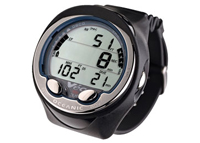Dive computer

During the last years dive computers became very popular. The compact devices can be worn like a watch on the wrist or be incorporated in a gauge console.
Basically they are a combination of a watch and a depth meter with a specific software to compute the nitrogen saturation of the diver’s body. Based on the decompression model the dive computer calculates non decompression limits and works out detailed instructions of depth and time to spend for decompression stops. As the computer is tracking the changing gas levels during each individual dive and the nitrogen desaturation between the dives over multiple dives it should not be shared, but stay always with the same diver.
Most models give an acoustic and visual alert when the diver exceeds the recommended ascent speed.
Dive computers can have a lot of further options:
- Nitrox (Enriched air) compatible computers have the opportunity to adjust the oxygen percentage manually, so the settings will track the diver's oxygen exposure as well
- Air integrated scuba computers measure the tank pressure and estimate the remaining dive time based on the depth and the breathing frequency. They are either attached to the first stage by a high pressure hose or get signals from a transmitter on the regulator. The air integrated device can replace a SPG, but the diver should be aware, that in case of a failure he will not have any information about the remaining tank pressure.
- A temperature indicator is a common feature of almost every model.
- Some computers come with a built-in digital compass as a valuable navigation tool.
- Scuba computers with an interface for computers to download the dive data provide detailed information about the dives.
The biggest advantage of a dive computer is that it allows longer bottom times. As the dive tables based on a square dive profile (maximum depth, maximum time) are consequently conservative, the computers track the accurate multi level profile of the dives, yielding longer non decompression times.
Even though scuba computers automate the nitrogen management it is still indispensible that each diver learns how to plan his dives safely by using the manual dive tables. Together with a watch and a depth gauge he will always have a backup to perform his ascent in an appropriate way in case of a malfunction of the computer.
To decide on a dive computer is always a matter of personal needs and preferences. The diver has to be aware of the features he requires for his type of diving.
Find below some options, which you should take into consideration when purchasing a computer:
- Is there a "low battery" warning and is it easy to change the battery?
- For cold water diving - the buttons of the device should be big enough to handle with neoprene gloves.
- For diving in low visibility or dark - the display should be easy to read and back-lit.
- For tec-diving - the software must be able to handle other gases than normal air, such as Nitrox, Trimix, Oxygen.
To get advice ask the instructors, or share your opinions with other divers in the diving equipment forum.
Look at the diving center directory to find a dive shop or diving center in your region.
All information and opinions provided are general and no substitute for professional advice. Always check with your diving instructor what fits best to your personal needs and to your level of training.











